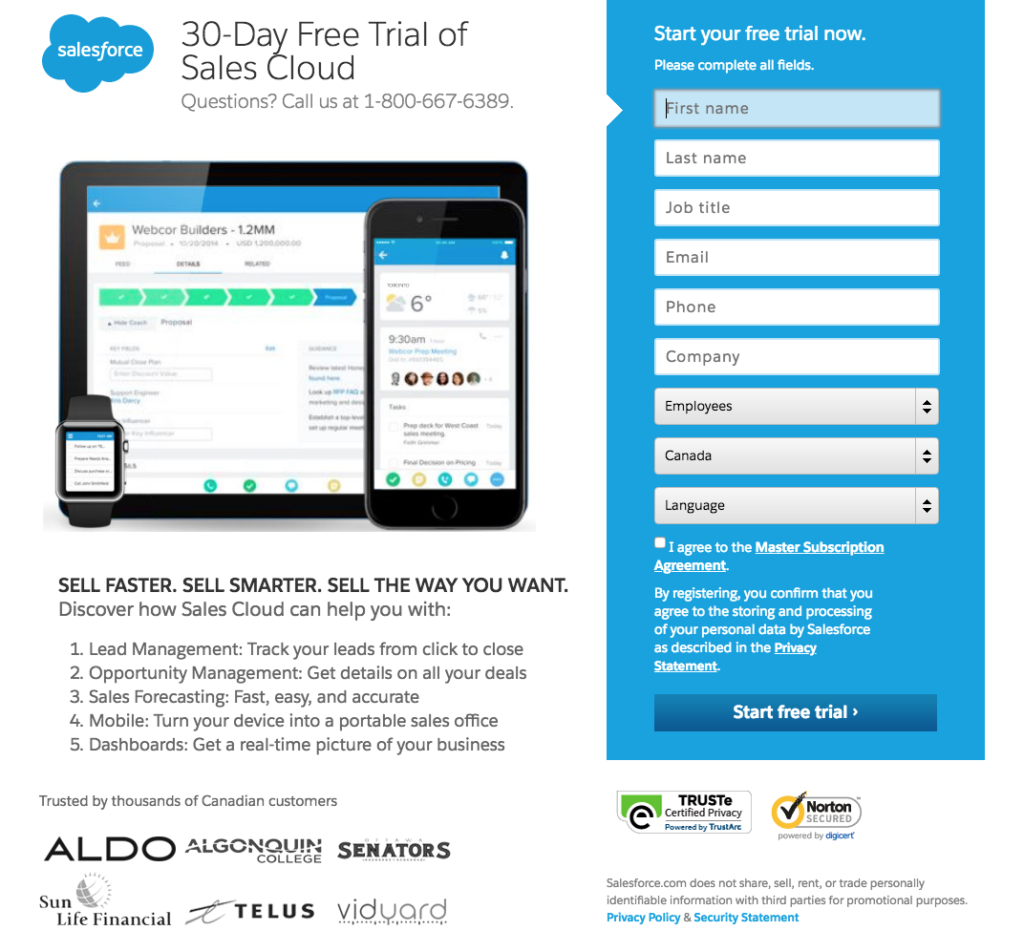Guest author: Molly Gibson Kirby
You know your SaaS company has a really good free trial, but are enough people converting to paying customers after the trial?
Probably not.
Typical trial conversion rates from a visitor to a customer in SaaS are 2%. This means if you have 10,000 web visitors, 200 will become free trial users and 30 of those users will become paying customers. Increasing these numbers are one of the biggest pain points for SaaS marketing departments.
In order to get your trial users to become paying customers, you need to make your free demo something these prospects can’t live without.
If you want to better your SaaS free trial, you need to change your strategy. It is possible to upgrade your conversion rate from 2% and that’s where this article comes into play.
In this article, we’re sharing 5 effective SaaS product trial strategies you can start using today to acquire more paying customers.
Two Types of SaaS Trials
For the majority of software products, the question isn’t – should I have a free trial? The question is – what sort of free trial should I have?
When creating a SaaS product trial, it’s important to note which type of trial your company is offering. Below are the two different types to decide between.
Opt-out Free
Opt-out trials are the free trials that require a credit card to begin. The free trial will turn over into a subscription at the end of the trial if the prospect does not opt-out. If a free trial requires a credit card, the average visitor to retained customer conversion rate is around 0.6%.
This type of trial needs to have hard work behind it in order to get people to give out their credit card information before the trial even begins.
Opt-in Free
The Opt-in trials are the free trials that can be started without a credit card. Prospects will need to opt-in to a subscription by providing payment details during or after the trial is finished.
According to Totango, if a credit card is not required, the visitor to retained customer conversion rate increases to approximately 1.2%.
This type of trial needs to have hard work behind it to get people to become customers once the trial is up.
Now that you understand the types of free SaaS product trials, let’s get started on the strategies we know that help boost product trial ROI.
Make Sign Up Simple

The fewer barriers that you put in the way, the more likely it is that people will sign up and opt-in for your SaaS trial.
Consider what information your SaaS company needs for the free trial. This goes back to the two types of trial sign-ups. Are you going to do an opt-in or an opt-out free demo? This will determine if credit card information is needed in the form.
Keep the signup short, don’t ask for a separate username, simply use their email as a username.
Also, consider using social logins for account creation. This has become a popular feature for many SaaS companies and makes it easier for people to get started on their free trial without wasting time inputting all their information.
Create Engaging Content
In addition to having a free trial, creating content that relates to the SaaS demo is pivotal.
Users may have questions or concerns about the trial. Having the content that answers these questions will allow them to feel like your SaaS company is credible and authoritative. Start by creating a landing page for your free trial. Include an FAQ section on this page and a how-to guide on using the software, so people see it right when they sign up. Then make sure you have content regarding the free trial and how it can solve a customer’s problem on your blog.
Once you have these key pieces of content, get creative and begin to think of other ways to add valuable and educational content where it fits.
Show Your Value
However good your SaaS product is, the simple truth is that no-one will buy it if they don’t believe they need it. You need to show people what your product can do for them.
Articulate your value proposition on your website, landing page, content and in all marketing campaigns. Once you do that, any visitor should be able to tell what you offer, who needs it, what they will gain having it and finally, why they should choose your company.
Take Salesforce for example.

On their 30-day free trial landing page, they provide everything we just mentioned above.
Value Proposition: Sell Faster. Sell Smarter. Sell the way you want.
What’s offered: Sales Cloud
Who needs it: Canadian companies with a focus on sales managers
What they gain: lead management, opportunity management, sales forecasting and a mobile sales office.
Why choose Salesforce: Trusted by thousands of Canadian customers.
Salesforce does an incredible job at showing their value without sounding too preachy. When creating your SaaS free trial landing page, be sure to include these five sections we just mentioned.
Fix Your CTA
The effectiveness of your Call to Action (CTA) can make or break your marketing. It is the one piece that actually gets your visitors to take action – hence the name. A CTA should make visitors want your product, it should create an urgency for signing up and it should be an easy-to-use form!
Make your CTA visible on the homepage. This allows new visitors to see the CTA, hook them into thinking they need to try the free trial and have them easily sign up right then and there.
Exit Survey
On the same note as engagement, it’s imperative that you conduct an exit survey once someone is finished their free SaaS trial. If a user doesn’t move to a paid plan, it’s valuable to know why. After a week of not upgrading, an email should be sent out to ask why they cancelled.
Sometimes they leave because it wasn’t what they were looking for, but sometimes they’re not fans of a specific part of the trial/software. The latter reason usually can be fixed with needed changes or upgrades to the software.
As you may have noticed, user feedback is key when bettering your SaaS trial.
In the End
In the end, if you apply these strategies and tips, your SaaS trial should perform better. It’s possible for the conversion rate from a trial user to a paying customer to increase from 2%. It will just take time, commitment, user feedback and a handful of a/b tests.
Are you ready to better your SaaS product Trial ROI?
Author’s Bio
Molly Gibson Kirby is a writer and marketing strategist at Roketto, an inbound marketing agency in British Columbia. She dives deep into the world of inbound marketing on a daily basis and writes about this fundamental shift in business on Roketto’s blog. When not writing, she’s either on her yoga mat or getting lost in a new book.







